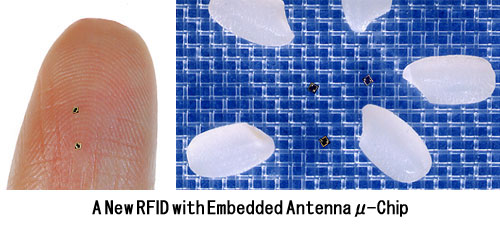Microchip implants ready for use with swine flu vaccine
Dienstag, den 01. September 2009 um 15:24 Uhr
News - Latest News
| Weiter > |
Among the very first visitors to my birdflu666 blog was an Austrian manufacturer of RFID chips, strongly suggesting the notion that microchips are intended to be used in any mass vaccination campaign, hence the Austrian chip manufacturer's keen interest in my criminal charges against Baxter.
Another US manufacturer in Florida is also working on "pandemic" microchip implants.
LIFE WITH BIG BROTHER
Next step in H1N1 scare: Microchip implants
Company developing under-the-skin devices to detect 'bio-threats'
Posted: August 22, 2009
11:50 pm Eastern
By Drew Zahn
© 2009 WorldNetDaily
A Florida-based company that boasts selling the world's first and only federally approved radio microchip for implanting in humans is now turning its development branch toward "emergency preparedness," hoping to produce an implant that can automatically detect in its host's bloodstream the presence of swine flu or other viruses deemed a "bio-threat."
VeriChip Corporation currently sells a small, under-the-skin Radio Frequency Identification capsule, or RFID, that patients can opt to have implanted, containing a number computer-linked to their medical records, enabling doctors with a special reader to access the information even if the patient is unconscious or unidentified. The company boasts its microchip, roughly the size of a grain of rice, is the only such implant approved by the U.S. Food and Drug Administration.
But VeriChip has also turned its attention to other uses for the technology, including microchips that be used to tag and log human remains after a disaster and implants the company hopes will be able to warn if their host is infected with the H1N1 swine flu virus, the H5N1 bird flu virus or other pandemic agents deemed to be a "bio-threat."
VeriChip is working with a Minnesota company, Receptors LLC, to develop the virus-detection technology.
"As we continue to build on our partnership with Receptors, which started with the development of a glucose-sensing RFID implantable microchip, we are moving beyond patient identification to sensors that can detect and identify illnesses and viruses such as influenza," said Scott R. Silverman, chairman of VeriChip, in a statement. "This is an exciting next step for the future of our healthcare division."
According to a joint white paper released earlier this year by both companies called "An Integrated Sensor System for the Detection of Bio-Threats from Pandemics to Emerging Diseases to Bio-Terrorism," the research's goal is to transform existing glucose-detection technology into pinpointing viruses instead, then couple it with an "in vivo" – meaning implanted inside a living organism – microchip that can alert others of the virus' presence.
The ultimate goal is to develop an implant that can also diagnose which virus is infecting the host.
VeriChip has also announced earlier this month additional forays into emergency preparedness through its VeriTrace system.
According to a statement, the company sold a VeriTrace system, including 1,000 RFID microchips, to Kentucky's Green River District Health Department "for disaster preparedness and emergency management needs."
The company explains that VeriTrace, a separate system from its virus detection or patient records technology, was created in the aftermath of Hurricane Katrina, where it was used by the Federal Disaster Mortuary Operational Response Team. The system includes the microchips, a Bluetooth handheld reader, a customized camera that receives both RFID scanned data and GPS data wirelessly and a web-based database for storing information and images captured during emergency response operations.
The microchips are implanted in human remains following a disaster or, according to one report from the Katrina catastrophe, duct-taped to bones, in order to maintain detailed records, particularly in events that result in hundreds or thousands of fatalities.
"This database ensures the precise collection, storage and inventory of all data and images related to remains and the associated evidentiary items," the statement boasts. "This also allows the recreation of an accurate and complete reconstruction of a disaster setting, crime scene or similar setting where recreation is necessary."
Since Hurricane Katrina, the RFID Journal reports, the Georgia Bureau of Investigation, the Hawaii Department of Health, the Florida Emergency Mortuary Operations Response System and the medical examiner's office in the Department of Heath in Erie County, N.Y, have also purchased the system. Earlier this year, VeriChip announced sales to Maryland's Calvert Memorial Hospital and to Mercer and Atlantic counties in New Jersey.
WND contacted VeriChip seeking information on its progress in developing the virus detection technology and other emergency preparedness microchip implants, but received no response.
| Kommentare |
|
|
""There's no way in the world, having read this information, that I would
have one of those chips implanted in my skin, or in one of my family
members," Dr. Robert Benezra, head of the Cancer Biology Genetics Program at
the Memorial Sloan-Kettering Cancer Center in New York, told AP.
"I mean, these are bad diseases. They are life-threatening. And given the
preliminary animal data, it looks to me that there's definitely cause for
concern."
Als see http://www.wnd.com/index.php?fa=PAGE.view&pageId=87945
Dog bleeds to death from ID chipping
'This technology is supposedly so great until it's your animal that dies'
and http://www.dailypaul.com/node/101246
Suspected Microchip in H1N1 Vaccine?
Posted July 29th, 2009 by SusanneV
Is this a possibility?
| AntwortenZitat |


 Microchip implants ready for use with swine flu vaccine
Microchip implants ready for use with swine flu vaccine
What about magnets??
I'm pretty sure you can fry an rfid chip using a magnet. If you're really paranoid, use a magnet from the back of a large speaker or amplifier.